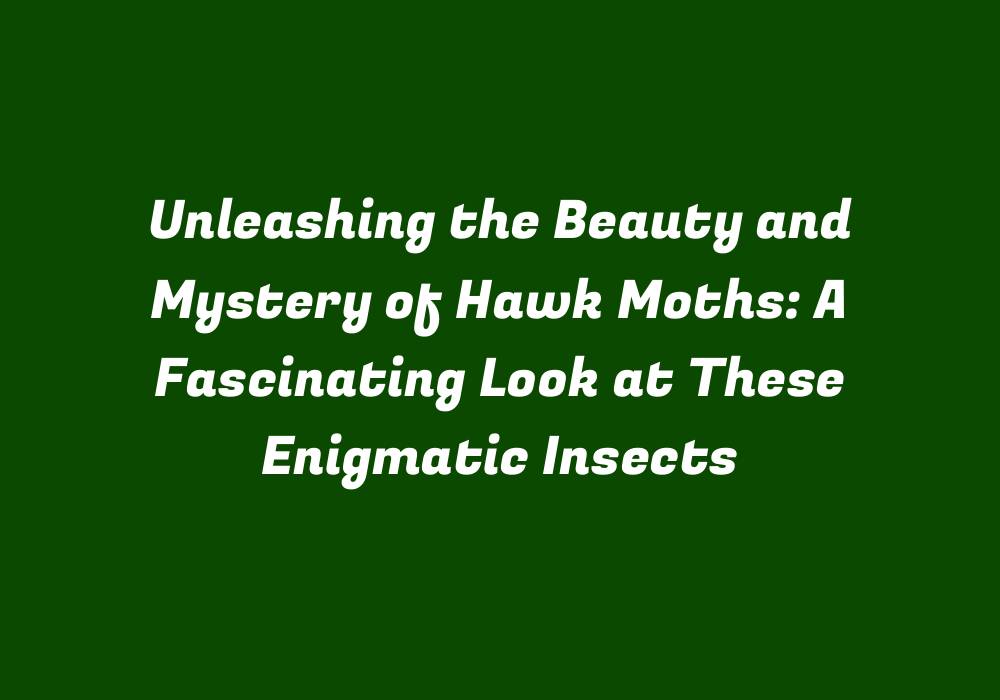Unleashing the Beauty and Mystery of Hawk Moths: A Fascinating Look at These Enigmatic Insects
Introduction
Hawk moths, also known as sphinx moths or hag moths, belong to the family Sphingidae. These captivating creatures are often found in various parts of the world and come with a diverse range of appearances and behaviors. With their unique traits, they have captured our fascination for generations. In this article, we explore the fascinating aspects of hawk moths that make them so intriguing to study and admire.
Habitat and Distribution
Hawk moths can be found in almost every part of the world, with the exception of Antarctica. They are commonly seen across Europe, North America, South America, Africa, Asia, Australia, New Zealand, and many islands in the Pacific and Atlantic Oceans. These insects prefer habitats that include a variety of vegetation types like woodlands, meadows, gardens, orchards, and even urban environments with street lamps and outdoor lighting.
Appearance and Behavior
Hawk moths are known for their incredible variety in size, shape, color, and patterns. Some species can have wingspans of up to 20 centimeters (8 inches), while others have smaller bodies with a more delicate appearance. Their wing designs feature distinct markings that help identify them from one another. Many hawk moths have a strikingly resemblance to hummingbirds, which helps them avoid predators.
These insects are nocturnal and often feed on nectar and pollen found in flowers, much like butterflies and bees. They rely heavily on their sense of smell to locate food sources, with some species being more specialized than others regarding preferred flower species. Hawk moths have an ability to hover in the air while feeding, which is a unique feature that makes them stand out from other moth species.
Reproduction and Life Cycle
Hawk moths reproduce through a process called oviposition, where females lay their eggs on or near their host plant’s leaves. The larvae of hawk moths are commonly known as sphinx caterpillars and are often highly camouflaged to avoid predation. They primarily feed on plants within the family Sapindaceae, which includes trees like hoptree and soapberry. Some species have a more specialized diet, while others exhibit generalism in their feeding habits.
The larvae go through several stages of development, known as instars, before entering the pupal stage. During this time, they molt their skin to grow and transform, eventually developing into a mature caterpillar. As they near maturity, sphinx caterpillars start preparing for their transformation into adult moths by spinning silk threads from glands on their bodies. These threads create a protective cocoon, where the caterpillar will undergo metamorphosis to emerge as an adult hawk moth.
Interesting Facts and Behavioral Patterns
Hawk moths are known for their remarkable adaptations and abilities that set them apart from other insects. Here are some interesting facts about these captivating creatures:
1. Sensitive Hearing: Hawk moths have specialized ear structures called tympana, which allow them to detect sound waves in the air. They can use this ability to locate their host plants and communicate with each other through vibrations or “courtship songs.”
2. Mimicry: Some species of hawk moths have evolved to look like wasps or bees to deter predators from attacking them. These insects benefit from the reputation that these creatures often possess as dangerous or unpalatable prey for their would-be predators.
3. Long Wingspan: Hawk moths’ wingspan can range from 5 centimeters (2 inches) up to 20 centimeters (8 inches), which allows them to fly at higher altitudes and greater distances than most other moth species. This ability aids in their migration patterns and long-distance dispersal.
4. Unique Courtship Rituals: Hawk moths have elaborate courtship rituals that involve complex flight displays, visual signals, and pheromones. These behaviors help attract mates and establish pair bonds for successful reproduction.
5. Phenology: The life cycles of hawk moth species can vary significantly depending on their habitat and seasonal conditions, with some having multiple generations per year while others have only one generation annually. This adaptability allows them to survive in a wide range of environments throughout the world.
Conservation Efforts for Hawk Moths
While hawk moths are generally not considered threatened or endangered species, their habitats and host plants are under continuous pressure due to various factors like habitat loss, pollution, and climate change. To ensure the future of these fascinating insects, it is essential to promote conservation efforts and focus on preserving their natural environment.
Conclusion
Hawk moths, with their mesmerizing beauty and diverse behaviors, are a unique group of creatures found across various regions of the world. By understanding their habitat, appearance, behavioral patterns, and life cycle, we can appreciate these enigmatic insects even more for their resilience and adaptability in navigating the intricate web of life. As we continue to learn from them, they remain an invaluable asset to our ever-changing ecosystems.
